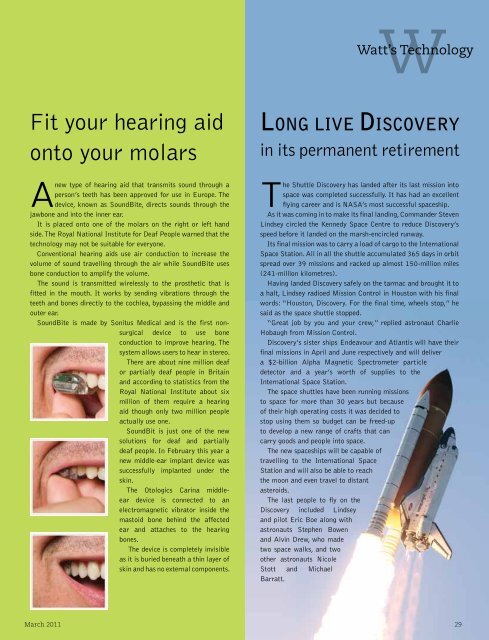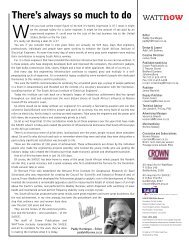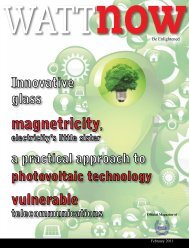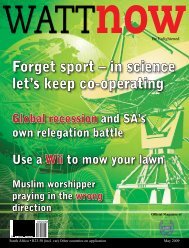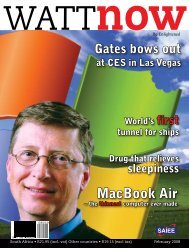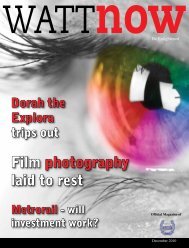download a PDF of the full March 2011 issue - Wattnow
download a PDF of the full March 2011 issue - Wattnow
download a PDF of the full March 2011 issue - Wattnow
- No tags were found...
You also want an ePaper? Increase the reach of your titles
YUMPU automatically turns print PDFs into web optimized ePapers that Google loves.
WWatt’s TechnologyFit your hearing aidonto your molarsAnew type <strong>of</strong> hearing aid that transmits sound through aperson’s teeth has been approved for use in Europe. Thedevice, known as SoundBite, directs sounds through <strong>the</strong>jawbone and into <strong>the</strong> inner ear.It is placed onto one <strong>of</strong> <strong>the</strong> molars on <strong>the</strong> right or left handside. The Royal National Institute for Deaf People warned that <strong>the</strong>technology may not be suitable for everyone.Conventional hearing aids use air conduction to increase <strong>the</strong>volume <strong>of</strong> sound travelling through <strong>the</strong> air while SoundBite usesbone conduction to amplify <strong>the</strong> volume.The sound is transmitted wirelessly to <strong>the</strong> pros<strong>the</strong>tic that isfitted in <strong>the</strong> mouth. It works by sending vibrations through <strong>the</strong>teeth and bones directly to <strong>the</strong> cochlea, bypassing <strong>the</strong> middle andouter ear.SoundBite is made by Sonitus Medical and is <strong>the</strong> first nonsurgicaldevice to use boneconduction to improve hearing. Thesystem allows users to hear in stereo.There are about nine million deafor partially deaf people in Britainand according to statistics from <strong>the</strong>Royal National Institute about sixmillion <strong>of</strong> <strong>the</strong>m require a hearingaid though only two million peopleactually use one.SoundBit is just one <strong>of</strong> <strong>the</strong> newsolutions for deaf and partiallydeaf people. In February this year anew middle-ear implant device wassuccess<strong>full</strong>y implanted under <strong>the</strong>skin.The Otologics Carina middleeardevice is connected to anelectromagnetic vibrator inside <strong>the</strong>mastoid bone behind <strong>the</strong> affectedear and attaches to <strong>the</strong> hearingbones.The device is completely invisibleas it is buried beneath a thin layer <strong>of</strong>skin and has no external components.Long live Discoveryin its permanent retirementThe Shuttle Discovery has landed after its last mission intospace was completed success<strong>full</strong>y. It has had an excellentflying career and is NASA’s most successful spaceship.As it was coming in to make its final landing, Commander StevenLindsey circled <strong>the</strong> Kennedy Space Centre to reduce Discovery’sspeed before it landed on <strong>the</strong> marsh-encircled runway.Its final mission was to carry a load <strong>of</strong> cargo to <strong>the</strong> InternationalSpace Station. All in all <strong>the</strong> shuttle accumulated 365 days in orbitspread over 39 missions and racked up almost 150-million miles(241-million kilometres).Having landed Discovery safely on <strong>the</strong> tarmac and brought it toa halt, Lindsey radioed Mission Control in Houston with his finalwords: “Houston, Discovery. For <strong>the</strong> final time, wheels stop,” hesaid as <strong>the</strong> space shuttle stopped.“Great job by you and your crew,” replied astronaut CharlieHobaugh from Mission Control.Discovery’s sister ships Endeavour and Atlantis will have <strong>the</strong>irfinal missions in April and June respectively and will delivera $2-billion Alpha Magnetic Spectrometer particledetector and a year’s worth <strong>of</strong> supplies to <strong>the</strong>International Space Station.The space shuttles have been running missionsto space for more than 30 years but because<strong>of</strong> <strong>the</strong>ir high operating costs it was decided tostop using <strong>the</strong>m so budget can be freed-upto develop a new range <strong>of</strong> crafts that cancarry goods and people into space.The new spaceships will be capable <strong>of</strong>travelling to <strong>the</strong> International SpaceStation and will also be able to reach<strong>the</strong> moon and even travel to distantasteroids.The last people to fly on <strong>the</strong>Discovery included Lindseyand pilot Eric Boe along withastronauts Stephen Bowenand Alvin Drew, who madetwo space walks, and twoo<strong>the</strong>r astronauts NicoleStott and MichaelBarratt.<strong>March</strong> <strong>2011</strong> 29


